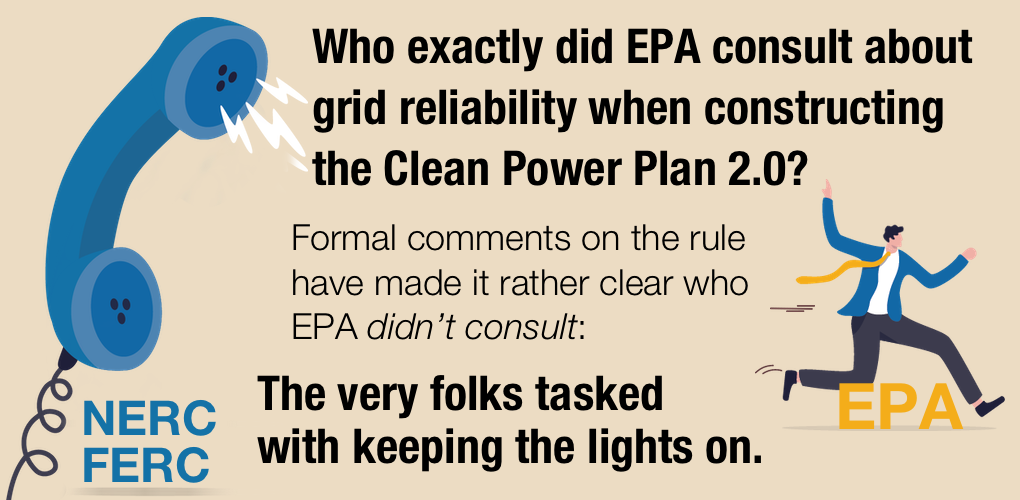
EPA’s UnINiformed Decisions
Who exactly did the U.S. Environmental Protection Agency (EPA) consult about grid reliability when constructing its so-called Clean Power Plan 2.0?
Formal comments on the rule have made it rather clear who EPA didn’t consult: the very folks tasked with keeping the lights on have made it abundantly clear the rule is a grave danger to resource adequacy and grid reliability. If not the on-the-ground experts, surely the EPA consulted the expert regulators at the North American Electricity Reliability Corporation (NERC) and the Federal Energy Regulatory Commission (FERC)? As we’ve come to find out, no.
In fact, while EPA claimed it consulted FERC, commissioner James Danly submitted a blistering letter to the agency correcting the record. “The EPA did not consult the Commission,” he wrote. “I was not asked what I thought of the Proposed Rule’s effects on electric reliability, and I am not aware of my fellow commissioners having had their feedback solicited.”
Danly, who has testified to Congress multiple times that the nation is facing a reliability and resource adequacy crisis, further requested that EPA extend the comment period for the proposed rule to allow a FERC technical conference on reliability scheduled for November to inform the EPA’s administrative record. In other words, if EPA is serious about hearing FERC’s expert opinion on the reliability impacts of its rule – as it claimed – it will wait for FERC analysis.
And as Danly observed, what should be under consideration is not just this single rule and its impact on grid reliability, but the suite of rules EPA is pushing as well as other public polices reshaping the nation’s resource mix. He wrote, “while the Proposed Rule could, by itself, significantly impair reliability, the Commission must also consider the Proposed Rule amidst the numerous other public policies that increasingly jeopardize the reliable operation of the bulk electric system.” He concludes, “until the record of FERC’s technical conference is submitted in the docket, the EPA will lack the record evidence necessary tomake an informed decision.”
Should we be surprised EPA has dropped the ball on reliability or, worse, misled the public about the modelling and analysis it performed on grid reliability when constructing its rule?
The answer is a resounding “no.” Despite ever-escalating warnings from the nation’s reliability experts and regulators, rapidly eroding reliability has become nationally endemic. Yet, it remains all but off the Biden administration’s radar, and firmly out of the administration’s talking points. Worse still, the administration seems to be living in a fantasy where the Inflation Reduction Act (IRA) is some kind of panacea to resource adequacy challenges when evidence continues to mount it’s likely exacerbating the problem.
If the administration is constructing a regulatory agenda built on the misguided belief that the IRA can fill the gaping holes left by accelerating retirements of traditional sources of power, we are destined for disaster. Tax incentives for renewable energy are no cure-all to vast permitting challenges, supply chain logjams, stubbornly persistent NIMBYism and soaring power demand from electrification, among a litany of other issues, creating a dangerous mismatch between the sluggish speed new generation and its supporting infrastructure are coming online and the breakneck pace at which traditional sources of power are pushed off the grid.
As the nation’s grid operators told EPA in their unprecedented comments on the Clean Power Plan 2.0, the proposed rule will lead to “significant power shortages.” They added, “If the technology and associated infrastructure fail to timely materialize, then the future supply of compliant generation — given forced retirements of non-compliant generation — would be far below what is needed to serve power demand…”
Nothing about these comments should be surprising to anyone – including EPA – that has paid any attention to grid reliability and resource adequacy over the past few years, or even the past few months.
This spring, Jim Robb, the president and CEO of NERC, was asked during testimony to the Senate Energy and Natural Resources Committee if the generating capacity EPA’s regulatory agenda is forcing off the grid can be sufficiently replaced without incurring reliability impacts. He said, “Not in the timeframe we’re looking at. No.” He added, “Interagency coordination is absolutely needed for policies that impact generation, especially coal resources, to keep reliability at the forefront of the policy table.”
There is only word to adequately describe EPA’s stubborn unwillingness to listen to or collaborate with the nation’s top experts and stakeholders on grid reliability: scandal.
- On August 16, 2023
